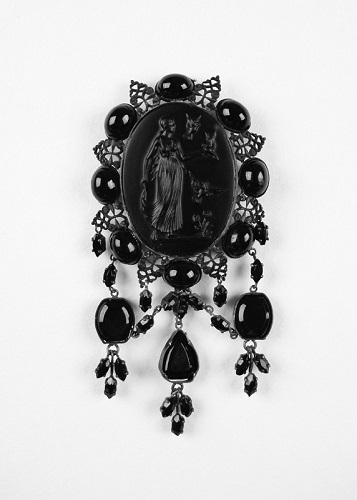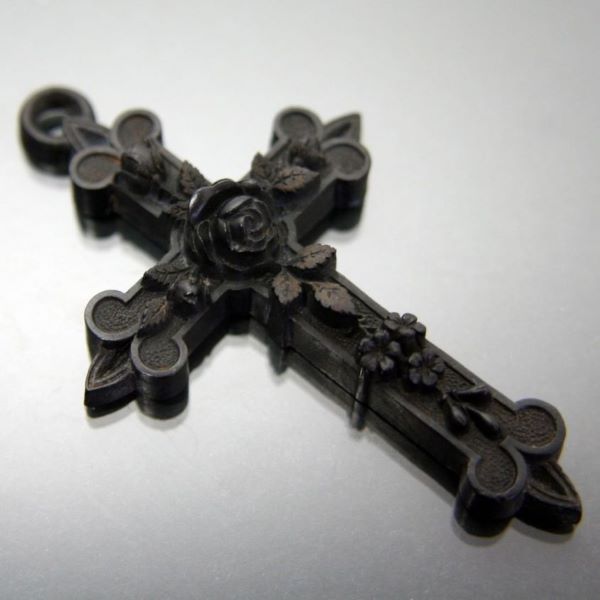1. Late Georgian death tradition and mourning customs
Vitae summa brevis spem nos vetat incohare longam
They are not long, the weeping and the laughter, Love and desire and hate:I think they have no portion in us after, We pass the gate. They are not long, the days of wine and roses:Out of a misty dream, Our path emerges for a while, then closesWithin a dream. (Symons, 1900, p.22) [1]
The only inevitable and certain events for humans, but also for all living beings are birth and death, as they symbolize the beginning and the end of a small or large cycle of development, experiences, practices and emotions. In the case of humans, whose first appearance is lost in the depths of time, each people or tribe had developed their own cultural identity which included traditional practices inextricably linked to the majestic meaning of death and were symbolized through a series of ritual burial customs (Reynolds, 2009, p.7) [2]. However, these numerous and quite different practices and values changed considerably over time and were always related to the peoples' hard living conditions caused by wars, diseases, famines, accidents, malnutrition, dirty water and lack of hygienic conditions. It should be noted, however, that the notion of mourning, despite the sharply differentiated mourning customs, has not changed much in European societies in recent centuries. Thus, to understand its still topical meaning as ‘a form of expression or experience that was the consequence of an event that marked the loss of a particular loved one and that caused intense and long-lasting grief’ during the late Georgian and Victorian period, we can only look back at the way in which mourning was treated according to the social stratification customs of the country (Robben, 2009) [3].
Starting the first part of our research from the late Georgian period and specifically a few years after the formal beginning of the Industrial Revolution in the 1760s, and concluding it at the end of the first three decades of the nineteenth century, we will find out that mourning was particularly important neither in individual nor in the collective consciousness of the English people, as it was in previous centuries. Especially with regard to the lower social strata, which constituted the majority of English population, we can see that due to their unfavorable social, working and economic conditions they kept almost none of the basic ritual burial traditions. For example, people usually did not enter the process of making and using special mourning clothes, did not organize special meals in honor of the deceased, nor did they follow any other costly ritual practices. This means that when loved ones died, they were buried by the family without special ceremonies, as their way of life forbade them to idealize death, but also to identify it with the concept of consumption (Jalland, 1996, p.40) [4]. Nevertheless, wearing black clothes during a certain period of time, regardless of their quality, style or use, was a classic mourning habit practiced for centuries and was considered perhaps the only mourning custom for the poor, working-class of England.
In contrast to this loose application of burial customs, the country’s aristocratic circles and, to a lesser extent, the emerging middle class followed a costly ritual practice that was often directed by specific traditional rules and etiquettes, especially in cases of national mourning. Thus, women often ordered special elegant mourning clothes from black, expensive fabrics, which over time were respectively replaced by dark purple or gray ones, while men simply wore black jackets with black ties and gloves, as well as black ornaments or crepe bands on their hats. There were no particular etiquettes as regards the time of mourning and the general mourning rules were rather slack in comparison to Victorian times.
2. The precious Georgian mourning jewelry
Mourning jewelry was also part of a long-standing bereaving tradition and was particularly expensive not only because of their construction materials, but also because of the almost always personal conditions under which they were designed. It is easy to see, then, that they were a dominant habit of the bourgeoisie, which could afford to buy them. It should be noted that during the late Georgian period most of jewelry designed and made in England, including some types of mourning jewelry, received several influences, from the French culture and taste, as most of decorative arts did (Crowley, 1990, p.15) [5]. One reason was that after the 1789 French Revolution, representatives of Napoleon’s imperial court, as well as financially powerful upper class citizens, began to show a keen interest in buying dear and impressive jewelry with large-sized precious stones and intricate techniques, which combined traditional, pompous Rococo aesthetics with the elegant Neoclassical style. It was therefore quite natural for British fashion to be directly influenced by the Parisian developments in taste and style, so as to start adopting many of them, despite the significant political differences and wars between the two countries between 1793 and 1815.
Precious gemstones such as rare diamonds, dazzling red rubies, green emeralds, glittering sapphires, genuine white pearls, crystals and ivory, quickly became the latest word in fashion. English goldsmiths combined them with gold, white gold, silver or expensive enamels and incorporated them into elaborate rococo and neoclassical designs of rings, earrings, pendants, smart short necklaces and simple but striking diamond chokers, which began to attract the interest of financially sound buyers.
There was little influence from the aesthetic style of the new French fashion, but also of any fashion that had preceded it, the mourning jewelry, mainly rings and pendants, known as Memento Mori or else Remember you will die, that is a particularly hard but truthful statement that reminded to the beholder the inevitability of death. These jewels, which usually bore this Latin phrase engraved on some part of their surface or contained elements strongly associated with death such as designs or forms of human skeletons or parts of them and even skulls, had their roots in the medieval tradition, while they were never meant to commemorate a person, in particular. According to medieval religious stereotypes, people should always have in mind the Divine Judgment, Hell, the importance of Forgiveness and Salvation, but also the Vanity of worldly life and to reconcile, even subconsciously, with the certainty of death (Braaten, 2011, pp.582-583) [6].
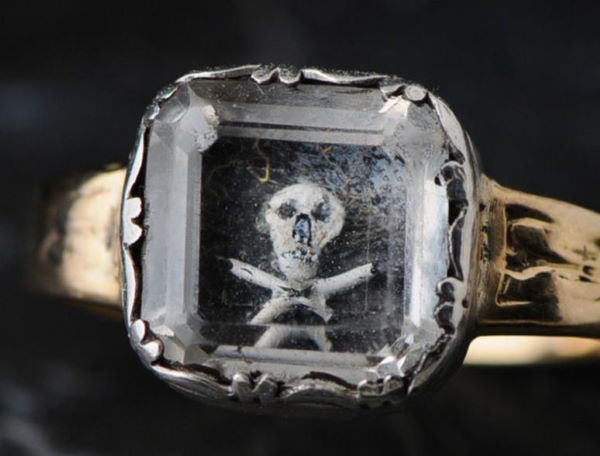
Fig. 1 Gold and silver Memento Mori ring with a skull, late eighteenth century. Source: Fabian de Montjoye.
Consequently this kind of jewelry which was either made for special purposes or passed down from generation to generation had such strong symbolism and continued to retain their basic characteristics, without being dramatically influenced by the changes of fashion, society, politics, nor by the cultural context of the decades that followed, prevailing especially in the intense mourning customs of Victorian times.
As for the other types of mourning jewelry, widely known as memorial jewelry, there was an effect on pieces such as brooches, rings, pendants and necklaces, from the end of the eighteenth century until the early Victorian period, especially in the use of precious metals, but also in the techniques used. However, in spite of the bright craziness of French jewelry, they kept a rather low design profile, as they were meant to be adapted to the gravity of the circumstances and the English tradition. As Stephanie Wytovich states in her book titled Mourning Jewelry … ‘mourning Jewelry isn’t something that you wear around your neck. It’s not fashion or a trend. It's something that you carry inside of you, something that no matter how much it screams, that you can just can't seem to let out’… (Wytovich, 2014, p.3) [7].
From a purely technical and aesthetic point of view, Georgian mourning jewelry was usually cast from gold, silver or a combination of both, but also from other metals such as copper and bronze in several modest and simple, but interesting designs. The gemstones used in their construction were of a limited variety, although there was an increase in the use of amethyst and diamonds. However, the use of enamels, crystals, pearls, ivory, onyx, mother-of-pearl, but also materials such as gold or silver wires, gold leaf, velvet and leather was quite common, while over time it became even more intense.
What needs to be emphasized, however, is the importance of the symbolism, the allegories, the special materials, the personal human stories, and especially the emblematic significance of mourning they bore. All these elements made memorial jewels unique and irreplaceable, regardless of their objective aesthetic, artistic or material value. Jewelry symbols such as figures, lettering or objects mainly painted on flat surfaces or embossed in cameo technique, or even natural materials such as human hair covered with glass layers were so powerful that, in many cases, made jewels be integral part of their owners’ legacy, as well as their descendants’.
Their most popular themes-symbols were taken from the then topical Neoclassical movement, such as the ancient urns, the eye portraits, the classic symbol of the heart, but also that of the weeping willow, the tree that was directly associated with the primordial sense of mourning. More macabre themes such as coffins and tombs were also popular.
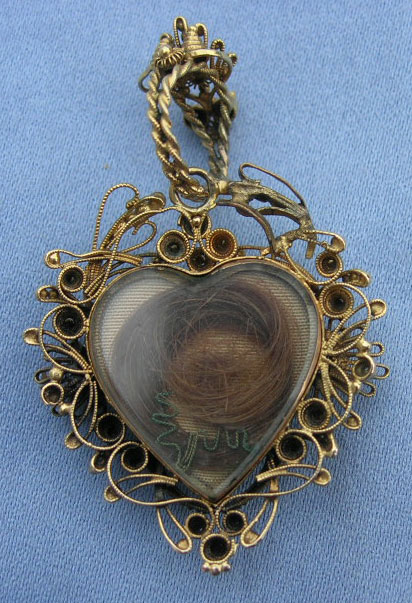
Fig. 2 Georgian gold mourning pendant in a heart shape with golden wire, glass and human hair, 1795. Source: Heyden Peters.
The heart, an always international symbol found in all cultures, was associated with eternal union, love, compassion and care (Tresidder, 2008, p.115) [8]. In Georgian memorial jewelry, either as a central theme in a painted or embossed form on a metal, ivory, enamel or leather surface coated with glass and decorated with precious stones, pearls, human hair or enamel, or as the main shape of a jewel, had always been meaningful and thus popular. However, it was not always about romantic love stories with a sad, mournful ending, as it was often the beloved symbol of mothers who lost their children, or even of children who mourned the loss of their siblings, parents, grandparents and other loved ones. Generally speaking, heart jewels frequently had love statements engraved on them and were used to lock away a loved one’s memory, keeping it intact from the passage of time.
Neoclassicism as an ideological and artistic movement born after the excavations in Pompeii and Herculaneum in the mid-eighteenth century was an important source of inspiration for the broad thematology of memorial jewelry which started gradually being adorned with the ancient symbols of victory, triumph, but also of burial ceremonial traditions (Bietoletti, 2005, p.10) [9]. Most important of all was probably the urn, a type of ancient elegant log-necked vase covered with a lid, which had a dominant role in both the social and cultural traditions of the ancient Greeks and Romans. Nevertheless, its roots go back to European and Asian cultures of prehistoric times, when people used it as a food storage container, but also as a burial vessel.
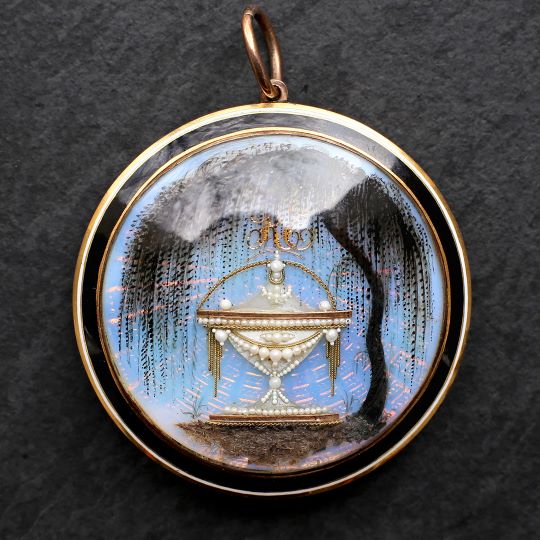
Fig. 3 Georgian mourning pendant with urn and weeping willow. Gold, glass, paint and pearls, 1800. Source: Heart and Heart of Hearts Antique Jewelry.
When they were used as funerary objects, urns served as special pots where the ashes of the cremated corpses were kept and thus they were strongly related to burial tradition ever since. During the Georgian era, the urn was adopted as a neoclassical, but at the same time timeless symbol and was used as a burial emblem in many aspects of art and architecture, despite the fact that entombment had already become the most popular method of burial, replacing the cremation process. So, we can see different types of urns depicted as funerary motifs in decorating a large part of the memorial jewelry of the time, either as sole symbols or combined with other symbolic themes such as the weeping willow tree, female figures in grief, tombs, angels, doves etc.
A very popular symbol on gravemarkers, tombstones and cemetery headstones in the early 1800s during the long neoclassical period, especially during the Greek Revival time, was the weeping willow tree (Dethlefsen, 2005, p.504) [10].
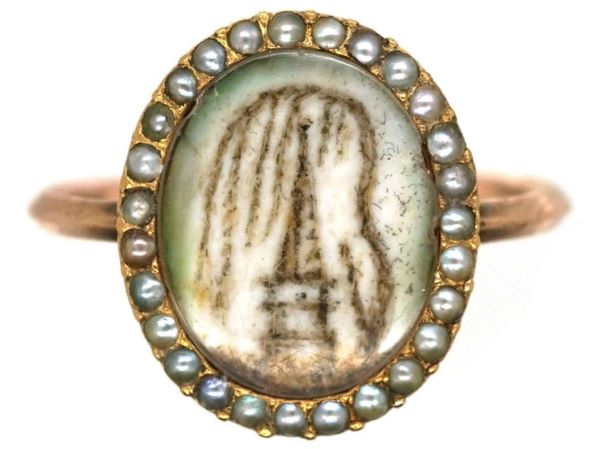
Fig. 4 Georgian mourning ring depicting an obelisk monument with a weeping willow tree. Gold, pearls, ivory, glass, early nineteenth century. Source: The Antique Jewelry Company.
For a long time, mainly because of its dropping branches with their light, fine and elegant leaves, it represented the tears, the sadness, the pain, the grief and the loss of the loved ones and was quickly included in the basic thematology of the late Georgian memorial jewelry. In comparison to the urn symbol, weeping willow tree represented people’s grieving feelings for the deceased, rather than the dark procedure of cremation. It can be found in abundance in bracelets, pendants, brooches and rings in a sepia painted form, engraved or embossed, usually in combination with female mourning figures, urns, tombs, graves, plinths or obelisk monuments.
After the first two decades of the nineteenth century, when the Industrial Revolution had already made great strides and this was seen in the mass production of many items including mourning jewelry, everything began to change (Smith, 1983, p.40) [11]. The fact that the precious metals and stones stocks were quite low at that time in combination with the great chances for mass production offered by new technology, the abundance of new materials, inventions and techniques, but also the ever-increasing demand of lower classes, pushed jewelry makers to find new ways of production. So, they gradually replaced gemstones with a kind of cheap but convincing enough glass paste and gold with pinchbeck, a mixture of zinc and copper, which was incomparably cheaper and had a quite similar final effect to the real material (Tolkien & Wilkinson, 1997, p.33) [12]. This was an opportunity mainly for most of the middle class consumers to start enjoying the much cheaper memorial jewelry pieces, in their desperate attempt to approach or even imitate the style, elegance, expensive lifestyle and finally the highest social position of people belonging to the haute-bourgeoisie of the country.
3. Victorian etiquette mourning rules
The Victorian era, which succeeded the Georgian era and began to emerge from the enthronement of Queen Victoria in 1837, and formally ceased to exist with her death in 1901, was the cradle of discoveries, inventions and technological innovations. At the same time, it was the most important period of the formation of social morals, of the strict differentiation of the social and cultural roles of the two sexes, as well as of the concepts of aesthetics and taste (Aslin, 1969, pp.13-14) [13].
Already, shortly after her coronation, Queen Victoria showed her power to influence the formation of the socio-cultural map of the country by artfully imposing specific ways of social behavior, adherence to family ideals and strict observance of many old traditions, one of which was the custom of mourning. As death was a common and frequent condition at that time, people were used to planning it from a young age. In fact, during the early Victorian era there was a boom in funeral-related businesses, including coffins, embalmers and gravediggers, which makes us realize that the phenomenon of death began to become even more important than some decades ago (Woodyard, 2014, p.35) [14].
This process was only a link in the long chain of social and personal obligations of women in particular, driven by national conservative traditions and customs, and sometimes by the personal experiences, demands or mere whims of Queen Victoria herself. Death rituals became much more important for English people after the sudden death of her husband, Prince Albert, in December 1861, a profoundly grievous event that plunged the palace, the country and of course the Queen herself into heavy mourning that lasted, though not with the same intensity, until her death (Rappaport, 2011, p.110) [15]. So overwhelming for Victoria was Albert’s loss that pushed her out of politics almost entirely, while she herself remained sad until her death, preventing even her children from any occasion of joy, laughter and happiness. After this tragic event, a strict list of etiquette rules and regulations regarding death, burials, and mourning emerged from the palace, obviously obliging people doing so. If these rules were not followed, then offenders were badly criticized for their immoral or dishonoring behavior to the dead. In spite of these regulations, British people, respecting Queen’s personal drama, followed her lead and set themselves patiently in the same long forty-year period of pain, mourning and grief through a series of complex customs, rituals and practices to commemorate their own deceased (Bedikian, 2008, p.35) [16].
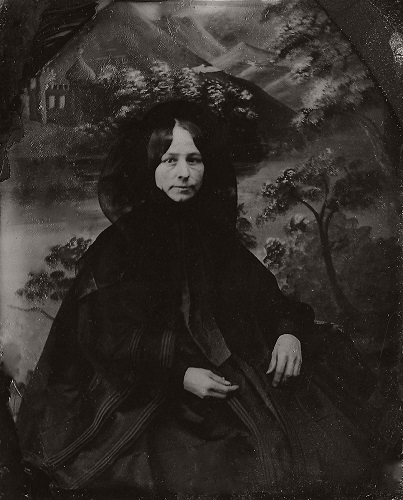
Fig. 5 Victorian widow in mourning in 1860s, daguerreotype technique. Source: MonoVisions Black & White Photography Magazine.
During that new period, the traditional custom of mourning began to change, becoming more stringent and demanding. For females, who constituted the stereotypical characters in mourning rituals, the period of mourning was divided into three phases: full mourning, second mourning and finally half mourning.
According to full mourning rules the complete isolation of mourners from social habits and intercourse was almost obligatory. Especially widows were forbidden to accept official invitations except from close relatives, avoided visits or other social contacts for reasons of entertainment and pleasure, and deliberately excluded themselves from public places other than the church. Their heavy sadness, mental and spiritual darkness were all reflected in the way they were dressed: their attires were made of dull silk or crepe, another type of fabric without gloss. They would wear black bonnets on their heads, their faces were always covered with heavy, black crepe weeping veils, while they wore carefully selected jewelry in small quantities (Hartley, 1872, pp.32-33) [17].
During the second phase of mourning, women were allowed to wear more mourning jewelry, their basic clothing was still made of crepe and the veil stopped covering the face; in fact it was not completely removed, as it was placed behind the head. It should be noted that elderly widows often remained in mourning for the rest of their lives (Bronte, 2018, p.8) [18].
Half mourning was much more relieving as it lasted from three to six months. Garments were made of more elaborate fabrics, while color such as grey, lilac and lavender, as well as many types of jewelry could be gradually introduced.
For men things were a little bit simpler: dark colored suits which could be combined with black gloves, hat and dark-colored cravat would normally be an ideal outfit. Sometimes, they also used to wear a black ribbon as an armband to show their deep grief.
4. Victorian mourning jewelry: objects of grief and fashion
Following the strict fashion of mourning in clothing, but also the corresponding customs and rituals that accompanied the period of mourning and voluntary social isolation, Victorian mourning jewels became objects that not only continued the tradition of the Georgian era, but were adapted to a new darker and more lugubrious reality. After 1861, the aesthetic and symbolic value of black color was almost completely linked to the concept of fashion, but also that of tradition, and almost extinguished any traces of the rest of the color palette from the vocabulary of designers and manufacturers of mourning jewelry. Black color for Victorians was directly related to the gloom of death and the deprivation of light, that is, the lack of perspectives for a happy life in the future. Thus, most jewelry of that period began to be made of black materials, although in many cases it was combined with other materials such as human hair or small precious stones, such as diamonds, but also pearls which often symbolized, such as and during the Georgian period, the precious tears of mourning.
The material that was widely used to make such jewelry, especially in the first years after Prince Albert’s death, mainly because Queen Victoria was the first to choose it, was Jet, also known as ‘black amber’, a natural material which was a variety of fossilized carbon and was collected in Whitby, Yorkshire (Gradstein et al., 2012, p.765) [19]. As expected it was particularly dear and could also be used in combination with precious metals such as gold or silver and several precious and semi-precious stones. For a long time, only jewelry made from this material should be worn by the bourgeois widows during full mourning, as it was the only to be socially acceptable from their class. In many cases, though, jewelry from very expensive and rare bog oak, unusual black onyx, exotic horn, but also the widely used black enamel could also be acceptable.
However, rapid technological development continued to provide solutions to the production of mourning jewelry, especially to middle-class female consumers who could not afford such expensive items. As we have already seen since the early nineteenth century, many new, inexpensive materials began to replace expensive ones. This practice continued into the Victorian era, when black, cheap glass, widely known as French jet replaced Whitby Jet, while jewelry made of vulcanite and gutta-percha, many times combined with pinchbeck, was proved to be the magic solution to the widespread demand for affordable mourning jewelry. These jewels, which were mass-manufactured, usually with various casting techniques such as plaster piece-molds, could also be worn by the haute-bourgeoisie widows, but only during the second phase of mourning which was less demanding and strict.
Most of jewelry we saw during the Late Georgian period continued to be designed during the Victorian period and included a wide variety of brooches, earrings, rings, bracelets, pendants, but also chains and cords with crosses.
As for the Memento Mori type of jewelry, they retained their original symbolic value and their special morphological characteristics, in general. There were, however, some exceptions with no obvious visual elements such as skulls etc., with engraved optimistic messages which encouraged people to enjoy life and its beauties. For instance, there were some wedding ring types which bore Memento Mori etched phrases on the inside part of the band which reminded young couples of enjoying the goods, pleasures and beauties of marriage, family and life in general, without forgetting their final destination, which was the same for all people. The rare application of white enamel on this type of jewelry would also symbolize the virginity of unmarried women and the innocence of young children who had passed away.
The rest of Victorian mourning jewelry was both vast in variety and exciting in forms and symbols. As in Georgian times, many items incorporated human hair; in this case, though, hair was used more intensively and in many different ways, as its application became the latest word in fashion after Queen Victoria’s decision to always keep a locket with a lock of hair of her late husband Albert. Thus, bracelets, rings, but mainly pendants, brooches and lockets incorporated more and more hair of the deceased loved ones, however in more perplex and elaborate forms and designs, than in the case of Georgian objects.
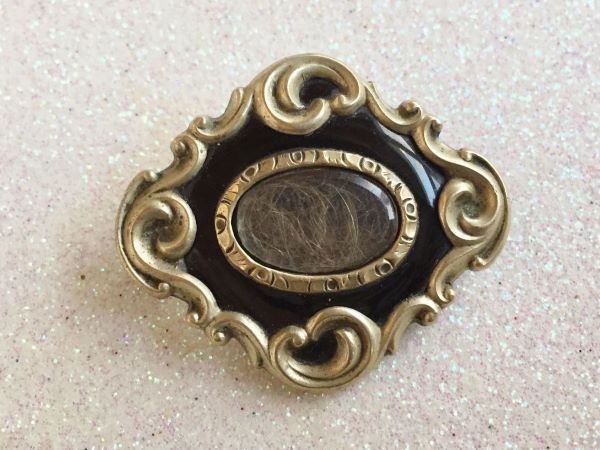
Fig. 7 Mourning Victorian brooch. Hair, with gold and black enamel. Original mid-Victorian era mourning brooch with hair, 1860’s. Source: Private collection.
In the 1860’s and 1870’s human hair broke the mourning jewelry boundaries, and became a new, independent fashion itself known as hair-work jewelry. The accessories of this type became particularly popular especially among the middle class consumers, as they were made entirely of woven human or even animal hair.
Symbolism in Victorian memorial jewelry design was an important issue and, apart from the basic Georgian symbols, it was also linked to an extensive variety of themes strongly associated with bereavement, such as ethereal female figures, flying birds, arrows, peacocks, phoenix, snakes, hands, crosses and flowers.
The hand was a very popular symbol, especially in the 1870s and 1880s, and was usually depicted on Jet, vulcanite and gutta-percha brooches, rings and pendants. As a specific, repetitive design of a female hand holding either individual flowers or a wreath of flowers, symbolized the power, the faith, the offering, the protection, the divine acceptance, and the good relations that mortals should have with the Heaven, which should constitute their final destination. The hand was also linked with the idealization concept, but also with that of immortalization of the beloved deceased.
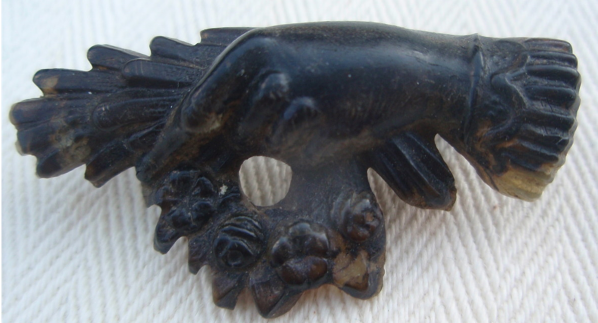
Fig. 8 Hand holding a flower wreath. Gutta-percha mourning brooch, 1880’s. Source: Private collection.
Flowers were closely associated with Victorian culture and were frequently used as popular decoration patterns adorning almost everything from wallpaper, clothes and frames to Valentine cards, book covers, furniture and metalwork. So it is not surprising that the language of flowers constituted a dynamic part of Victorian mourning jewelry symbology, which, however, needs to be interpreted accordingly.
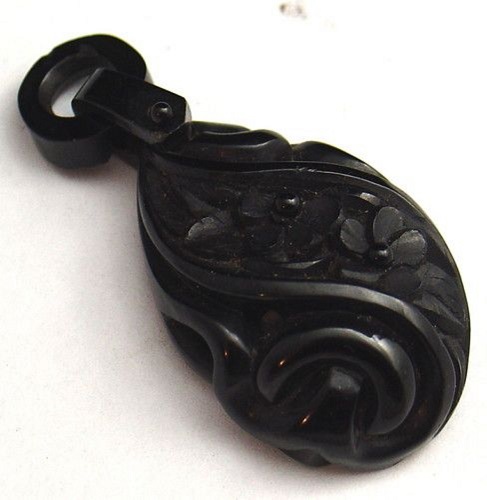
Fig. 9 1870’s Victorian Whitby Jet mourning pendant with forget-me-not flowers carved on it. Source: Private collection
Flowers such as roses signified the special love that God had for humans and His protection on the soul of the dead. It also signaled holiness, unconditional love, farewell and remembrance. Forget-me-nots, symbolized memory and remembrance, lilies-of-the-valley represented purity, but also the reuniting of the loved ones who had departed (Lehner & Lehner, 2003, p.32) [20]. Yews were associated with eternal life in Heaven, whereas thistles symbolized grief and sadness. Buds or half-open flowers carved or painted on a piece of mourning jewelry could reveal that someone grieved for a person who died in a very young age.
Crosses were undoubtedly the most powerful symbols of Christianity and religious ethics. They represented the connection between earth and heaven, the meeting point of death and resurrection and thus were inextricably linked with the holiness of passing away.
They were commonly acceptable as sacred expressions of mourning and were often worn along with long or short chains, cords and ribbons as pendants, in a variety of black materials. They also constituted popular motifs of other black jewelry pieces, such as bracelets and lockets, and were often adorned with a wide range of materials among which were ivory, mother-of-pearl, semi-precious stones, tortoiseshell and silver.
5. Conclusions
As stated in the above research, mourning jewelry constituted an extremely important aspect of the entire death culture in Great Britain, during the late Georgian and especially in Victorian period. It was observed that in both historical periods that shaped the social and cultural physiognomy of the country, the sensitive period of mourning, the burial habits, but also the material culture related to them, were directly influenced by the personal, aesthetic and moral values of the respective royal courts. In the case of the Georgian era, King George III’s unbridled passion for French Rococo culture and the Neoclassical ideal affected the taste and aesthetics of the time, but not catalytically as regards the burial customs and the formation of mourning jewelry design principles.
On the contrary, Queen Victoria’s personal disaster which sank her in an almost eternal mourning seemed to have drastically affected, in a however severely rigid way, death tradition, rituals and customs and therefore memorial jewelry design, accordingly.
By the end of the nineteenth century these restrictions started causing great discomfort and uneasiness and several other negative feelings to the mourners and by the time what was related to death customs started being considered as old-fashioned, outdated and unattractive. During the Edwardian era, and after the death of Queen Victoria, black mourning clothes, mainly for women but also for men, gradually began to be an unpleasant spectacle and questioned as socially necessary, as well as the majority of mourning jewelry. In the interwar period, and especially in the 1920s, middle and upper class women in Britain abandoned the strict Victorian mourning system, lost interest in buying bereaving jewelry again and sought out a new, happier and more optimistic lifestyle.














